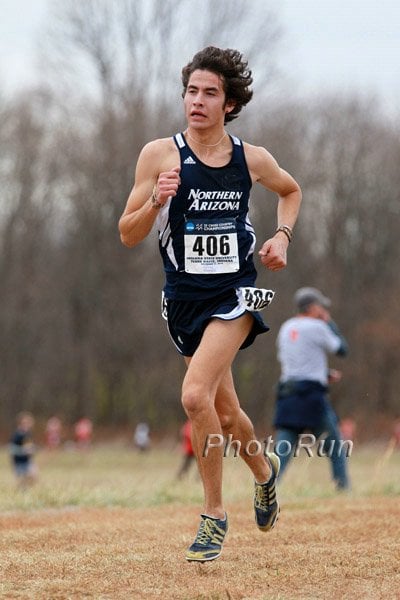Diego Estrada Would Have Been Eligible to Run the US Olympic Trials
By Weldon Johnson, LetsRun.com
May 3, 2012
Diego Estrada, the recent American citizen and redshirting junior at Northern Arizona who this past weekend ran 27:32.90 for 10,000m at Mt. Sac to qualify for the Mexican Olympic 10,000m team, would have been eligible to run the US Olympic Trials this year, but did not know this because he was given erroneous information.
After this weekend's 10,000m the proud recent US citizen, Estrada, explained to Flotrack why he was going to run for Mexico instead of trying to make the US Olympic team saying, "We couldn't get me eligible for the Trials and there was a lot of politics (involved)." He then added, "I apologize for anyone who is upset but that is my American dream being an Olympian... I had to do what I had to do. I had to chase the American dream."
I called Estrada's coach, Eric Heins the Track and Field coach at Northern Arizona, to find out why Estrada was ineligible for the US Olympic Trials.
It turns out Heins was erroneously told that Estrada wouldn't be eligible to run in the US Olympic Trails until waiting one full year after Estrada got his US citizenship in November of last year, which would have meant missing this June's US Olympic Trials. In fact, because of a new IAAF rule that went into effect of March of this year, Estrada would have been eligible to run at the US Olympic Trials because he had been a resident of the US for a year prior to being a citizen.

It turns out Estrada would not have to wait a year to run at the US Championships. Sarah Austin, Manager of Legal Affairs at USATF, pointed me to the new IAAF rule that went into affect March 12th of this year, that waives the one year waiting period for people who have been residents of their country for a year prior to citizenship. She wrote, "If an athlete wishes to transfer his/her allegiance in accordance with the rule outlined above, they would simply need to email USATF expressing this desire and provide the appropriate documentation (naturalization certificate, proof of residence, etc.)." Prior to this most recent rule change, athletes could not compete internationally until two years after getting citizenship. The new rule reduces this window to one year, but waives that if the new citizen has been living in the country for a year.
Heins said, "(Based on what we were told), we didn't think he'd be able to run at the Trials."
As a result, they then reached out to Mexican officials and the "Mexican officials were really wanting him to run for Mexico." The Mexican officials told Estrada he would run for the them in the Olympics if hit the Olympic qualifying mark which he did this last Sunday.
When asked if the US Trial eligibility might change anything for Estrada, Heins said, "It's kind of a no brainer for him now (to go to the Olympics for Mexico)". Heins said the Mexican federation was very supportive of Diego and promised to give him the resources to prepare for London.
Heins said Estrada ran the second half of the 10,000m at Stanford in 13:35 and was obviously thrilled with the result, "It's all really exciting for him."
This is only Estrada's fourth year of college and with a possible waiver to get a fifth cross-country season next year due to a medical reason, Estrada would still have one season of cross country, indoor and outdoor track remaining.
Currently, only American citizen, Chris Derrick who was two spots ahead of Estrada at Mt. Sac, has run faster than Estrada in college. If Estrada runs for Mexico at the Olympics, we're not sure if he'll be eligible for official US records, but being the fastest American collegian ever at 10,000m is a real possibility for Estrada next year.
Estrada has definitely come a long way from getting beat by 30 seconds by German Fernandez in the 3200 at the 2008 California State Meet.
The whole process shows the difficult of keeping up with the ever changing IAAF citizenship rules. The citizenship rules were designed to prevent running mercenaries from switching countries on a whim, but they inadvertently impacted Estrada who has lived in the US since childhood and actually was eligible to compete for the US as of March. In addition with the written rules, the IAAF always has given itself an out where it can do whatever it wants as the rules say, "the period may be reduced or cancelled in exceptional cases by the Council." The IAAF used the "exceptional cases" exemption to let world junior miler record holder Ilham Tanui Özbilen (William Tanui) run for Turkey at the World Indoor Championships which just happened to be in Turkey.
More: IAAF rulebook with old rules (Estrada would have had to wait 2 years)
*New Rules (No wait if you've been a resident for a year prior to citizenship. 1 year wait for everyone else. 3 year wait if you've competed for another country)
|
|
|
|
|
|
